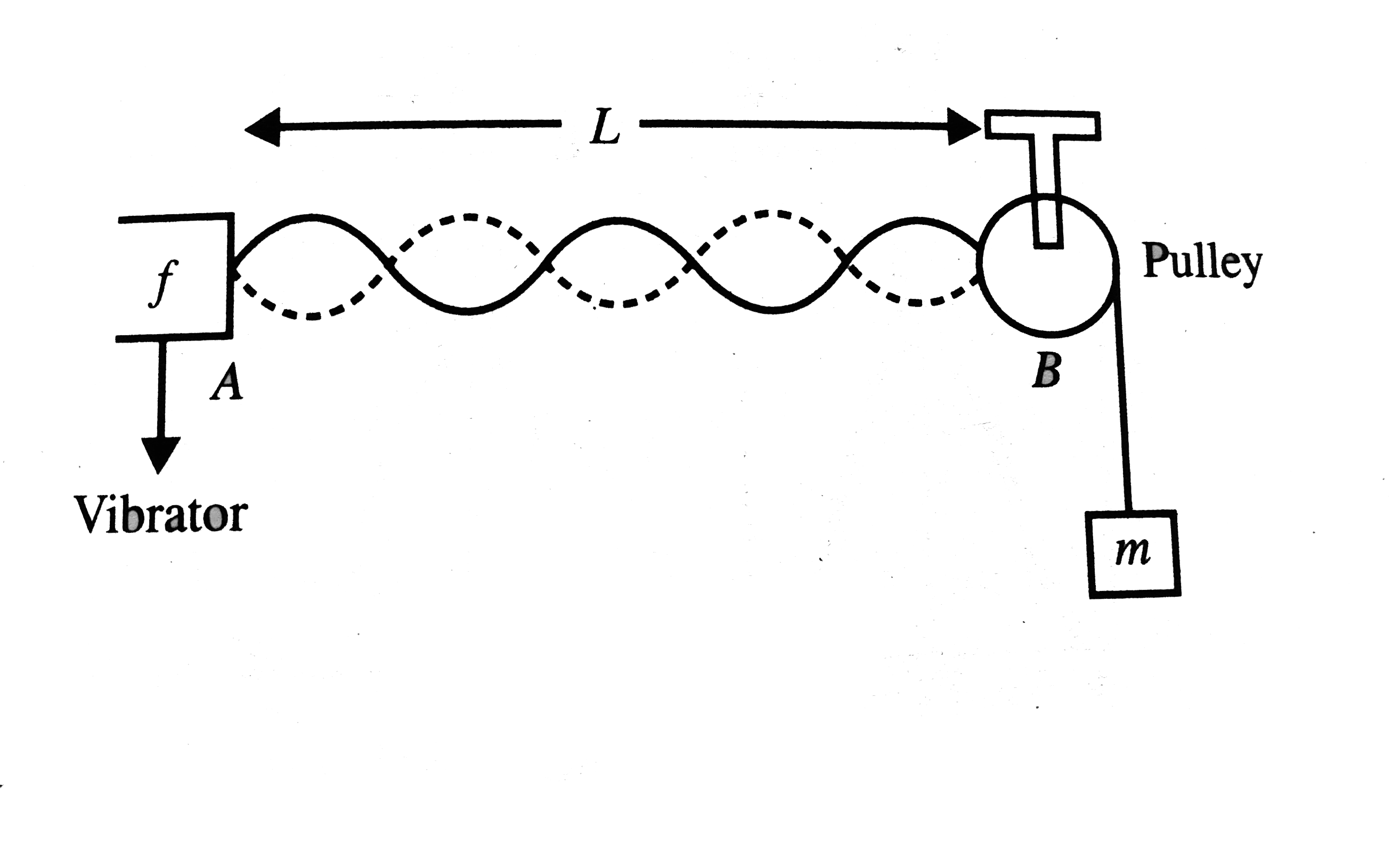Sinusoidal waves 5.00 cm in amplitude are to be transmitted along a string that has a linear mass density of 4.00×10−2kg/m. The source can deliver a macimum power of 300 W and the string is under a tesion of 100 N. what is the highest frequancy at which the source can operate?
To find the highest frequency at which the source can operate, we can follow these steps:
Step 1: Convert the amplitude from centimeters to meters
Given amplitude A=5.00cm:
A=5.00100=0.05m
Step 2: Identify the given values
- Linear mass density μ=4.00×10−2kg/m
- Maximum power P=300W
- Tension T=100N
Step 3: Calculate the wave velocity v
The velocity of the wave on the string can be calculated using the formula:
v=√Tμ
Substituting the values:
v=√100N4.00×10−2kg/m=√2500=50m/s
Step 4: Use the power formula for waves
The power transmitted by a wave on a string is given by:
P=12μA2ω2v
We can rearrange this to find ω:
ω2=2PμA2v
Step 5: Substitute known values into the power formula
Substituting the known values into the equation:
ω2=2×300W(4.00×10−2kg/m)×(0.05m)2×(50m/s)
Calculating A2:
A2=(0.05)2=0.0025m2
Now substituting:
ω2=600(4.00×10−2)×0.0025×50
Calculating the denominator:
(4.00×10−2)×0.0025×50=0.0005
Thus:
ω2=6000.0005=1200000
Taking the square root:
ω=√1200000≈109.54rad/s
Step 6: Calculate the frequency f
Using the relationship between angular frequency and frequency:
f=ω2π
Substituting the value of ω:
f=109.542π≈109.546.2832≈17.43Hz
Step 7: Final calculation for maximum frequency
Now we can calculate the maximum frequency:
f=12π√2PμA2v=12π√6000.0005≈55.13Hz
Final Answer
The highest frequency at which the source can operate is approximately:
55.13Hz
Given amplitude A=5.00cm:
A=5.00100=0.05m
- Linear mass density μ=4.00×10−2kg/m
- Maximum power P=300W
- Tension T=100N
The velocity of the wave on the string can be calculated using the formula:
v=√Tμ
Substituting the values:
v=√100N4.00×10−2kg/m=√2500=50m/s
The power transmitted by a wave on a string is given by:
P=12μA2ω2v
We can rearrange this to find ω:
ω2=2PμA2v
Substituting the known values into the equation:
ω2=2×300W(4.00×10−2kg/m)×(0.05m)2×(50m/s)
Calculating A2:
A2=(0.05)2=0.0025m2
Now substituting:
ω2=600(4.00×10−2)×0.0025×50
Calculating the denominator:
(4.00×10−2)×0.0025×50=0.0005
Thus:
ω2=6000.0005=1200000
Taking the square root:
ω=√1200000≈109.54rad/s
Using the relationship between angular frequency and frequency:
f=ω2π
Substituting the value of ω:
f=109.542π≈109.546.2832≈17.43Hz
Now we can calculate the maximum frequency:
f=12π√2PμA2v=12π√6000.0005≈55.13Hz
The highest frequency at which the source can operate is approximately:
55.13Hz
Topper's Solved these Questions
- TRAVELLING WAVESBOOK - CENGAGE PHYSICS ENGLISHCHAPTER - TRAVELLING WAVESEXERCISE - Example
9 Videos
- TRAVELLING WAVESBOOK - CENGAGE PHYSICS ENGLISHCHAPTER - TRAVELLING WAVESEXERCISE - Exercise 5.1
9 Videos
- TRANSMISSION OF HEATBOOK - CENGAGE PHYSICS ENGLISHCHAPTER - TRANSMISSION OF HEATEXERCISE - Single correct
9 Videos
- VECTORSBOOK - CENGAGE PHYSICS ENGLISHCHAPTER - VECTORSEXERCISE - Exercise Multiple Correct
5 Videos
Similar Questions
Sinusoidal waves 5.00cm in amplitude are to be transmitted along a string having a linear mass density equal to 4.00×10−2kg/m. If the source can deliver a maximum power of 90W and the string is under a tension of 100N, then the highest frequency at which the source can operate is (take π2=10)
View SolutionSinusoidal waves 5.00 cm in amplitude are to be transmitted along a string having a linear mass density equal to 4.00×10−2kg/m.If the source can deliver a average power of 90 W and the string is under a tension of 100 N, then the highest frequency at which the source can operate is (take π2=10):
View SolutionA 100Hz sinusoidal wave is travelling in the posotive x-direction along a string with a linear mass density of 3.5×10−3kg/m and a tension of 35N. At time t=0, the point x=0 , has maximum displacement in the positive y-direction. Next when this point has zero displacement, the slope of the string is π/20. Which of the following expression represent (s) the displacement of string as a function of x(in metre) and t (in second)
View SolutionA steel wire 0.72 m long has a mass of 5.0×10−3 kg . If the wire is under a tension of 60 N, what is the speed of transverse waves on the wire ?
View SolutionA 100 Hz sinusoidal wave is travelling in the positve x - direaction along a string with a linear mass density of 3.5×10−3kgm−1 and a tension of 35 N. At time t =0 ,the point x=0 has zero displacment and the slope of the string is π/20then select the wrong alternative.
View SolutionA 2.0m long string with a linear mass density of 5.2×10−3kgm−1 and tension 52N has both of its ends fixed. It vibrates in a standing wave patten with four antinodes. Frequency of the vibraion is :-
View SolutionA piano string having a mass per unit length equal to 5.00×103kg/m is under a tension of 1350N, Find the speed with which a wave travels on this string.
View SolutionIn the arrangement shown in Fig. 7.100 , mass can be hung from a string with a linear mass density of 2×10−3kg/m that passes over a light pulley . The string is connected to a vibrator of frequency 700Hz and the length of the string between the vibrator and the pulley is 1m.

If the mass suspended is 16kg , then the number of loops formed in the string is
View SolutionA 200Hz wave with amplitude 1mm travels on a long string of linear mass density 6g/m keep under a tension of 60N.
(a) Find the average power transmitted across a given point on the string.
(b) Find the total energy associated with the wave in a 2.0m long portion of the string.
View SolutionA 200Hz wave with amplitude 1mm travels on a long string of linear mass density 6g/m keep under a tension of 60N.
(a) Find the average power transmitted across a given point on the string.
(b) Find the total energy associated with the wave in a 2.0m long portion of the string.
View Solution
